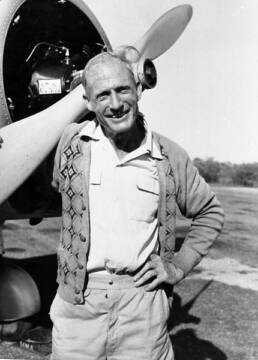These stories may contain descriptions of childhood trauma and abuse. Aboriginal and Torres Strait Islander people should be aware that this website may contain images, voices or names of people who may have passed away. If you need help, you can find contact details for some relevant services on our support page.
Australian aviator Horrie Miller (1893-1980) was in foster care as a child.
Horace Clive Miller was born in Ballarat, Victoria. His mother died of typhoid fever when he was only six months of age after which his father took him to Mildura where he worked as a store manager.
When Horrie was ten years old, his father left the child in foster care with a farming family in the Gippsland region of Victor while he went to the goldfields in Western Australia.
My rather blurred memories of this period are of intense loneliness and cold and what seemed to me then the terrible fate of having to milk cows every morning before walking five miles to a bush school. I made my escape as soon as possible, hiding out for some days in a mosquito-infested swamp. My formal schooling came to an end at a very early stage and I graduated, a shy, sandy-haired kid, to the harsh school of life (Miller, 1).
It is not clear for how long Horrie was in foster care, nor how many families he stayed with, but he does seem to have hated it.
After he left school, Horrie worked as an errand boy, assisting on a baker’s cart, and as a cleaner for a private car service. At some point Horrie’s father visited him in Melbourne and, knowing his son’s interest in the new motor vehicle industry, arranged to have the child apprenticed in a factory. Horrie kept the job for two years, but loathed it, he “hated being stuck in a smoke-filled factory and found the blinding light of furnace and forge poor substitute for the sun” (Miller, 3).
Horrie’s father died when Horrie was twenty and left him some money. The young man used the money to take up an interest in aviation, going to England with a friend and experiencing his first flight.
After all my thousands of flying miles and hours it is extraordinary how clearly I can recall every moment of this first experience…With what reverence I watched the gloved hand on the joystick, the feet outstretched on the rudder bar…With what elation I felt the rush of air as the grass skimmed past and under us and we were lifted over fences, roadways, roof-tops, fields. I sat enthralled, for often as I had imagined the sensation of flight, it was not quite as I had expected it. I had not known that it would be the earth that seemed to move, in magnificent panorama, under the suspended plan. The flattening glide that presaged our return to earth came all too soon for me… (Miller, 9).
Miller got a job in England as a mechanic with Thomas Sopwith who ran a stunt and exhibition business. He returned to Australia when World War I broke out.
While waiting to join the Australian Flying Corps he built his first aircraft, which he flew himself. After training Miller became a member of the first flying unit to go to England in 1916. He was trained as a fighter pilot… Late in 1917 he saw action in France. Early next year, in poor health, he returned to Australia and spent the rest of the war at Point Cook, Victoria, as a test pilot (Byrne).
Miller set up Australia’s first airmail run in 1924 from Adelaide to Sydney via Mildura, Hay, Narrandera and Cootamundra.
In 1927, he went into business with Sir McPherson Robertson, a chocolate manufacturer, forming a company called MacRobertson Miller Airlines and using its first aircraft to carry chocolates from Melbourne to Adelaide, “possibly the first such cargo [of perishables] ever to be transported by air (Miller, 128). Many of its early flights were medical emergencies, the company being harbingers of the Royal Flying Doctor Service. They also won a contract from the Federal Government to fly the mail. Initially based in Adelaide in suburban Albert Park and then at Parafield, the business combined Robertson’s business acumen with Miller’s enthusiasm for flying. MacRobertson Miller Airlines was bought by Ansett Airlines in 1963.
By the time Horrie Miller married author and historian Mary Durack (1913-1994), he was forty-five years old and recognised as a founding father of aviation in Australia. He went on to establish the airline industry in Western Australia and the couple had six children. One of the children was Robin Miller, a famous aviator in her own right as well as a nurse and dispenser of the vital polio Sabin vaccine to remote Aboriginal communities.
In 1977 Horrie Miller was awarded the Oswald Watt Gold Medal for the promotion of Australian aviation. The road into Perth International Airport is named after him, as is the road into Parafield Airport in South Australia.
References:
Byrne, Geraldine. “Miller, Horatio Clive (Horrie) (1893–1980).” Australian Dictionary of Biography, vol. 10, (1986). https://adb.anu.edu.au/biography/miller-horatio-clive-horrie-7586
Miller, H.C. Early Birds. Magnificent Men of Australian Aviation Between the Wars. Rigby, 1968.
Niall, Brenda. True North: The Story of Mary and Elizabeth Durak. Melbourne: Text Publishing, 2013.
Image available here.
